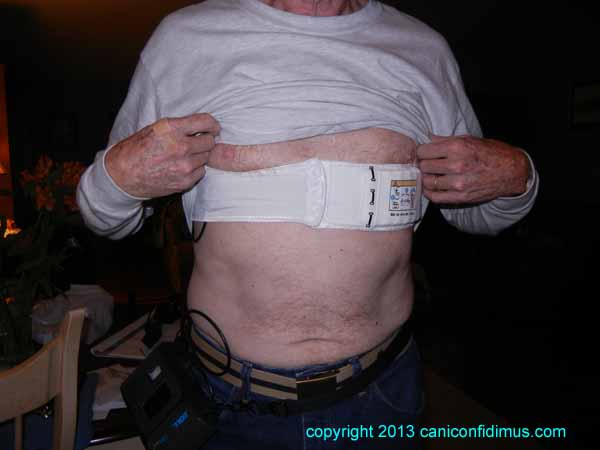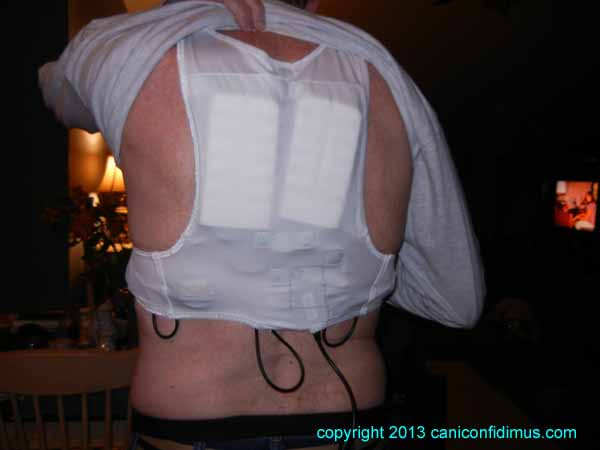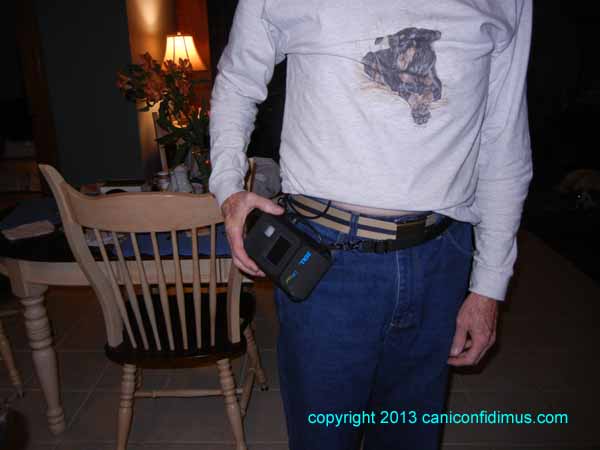Zoll Lifecor Corp. is the manufacturer of the wearable defibrillator that I got on Thursday. Here I am wearing it.

The defibrillator, hidden
I’m wearing my doberman shirt. The picture looks a lot like Bella, my second dobie. All you can see of the defibrillator is the control unit at my waist and the wire that goes from it to the bra.
Here it is, revealed.

Peek-a-boo
It’s like a bra, only backwards. You can see a wire on my right leading to one of the sensors. One of the shock units is over my left chest.
Here it is from the back.

Back view
You can see the other two shock units on the upper part. One of the sensor units is on my left side. It’s a round puck.
And here’s the control unit.

Control unit at my waist
The control unit has a thin, adjustable strap that I’m wearing around my waist. It’s almost the right size, but just a little long. It can also be lengthened and worn over the shoulder. I have been doing that occasionally, but it’s not comfortable. In fact, the unit is not at all comfortable. It’s bulky and it makes my back feel pretty warm, even on what has turned out to be two fairly cold days. Its bulk makes driving uncomfortable. And, of course, I have to do something with the control unit in order to get my seatbelt around my waist. I have been unhooking the strap and putting the control unit on the center console.
Thursday night was the first night I spent in the vest. There’s no forgetting that it’s there. If a woman’s bra is anywhere near as uncomfortable as this thing, I don’t see how women can wear them.
Zoll is supposed to send a second vest, because they recommend washing the one you wear every couple of days. I understand why. As I said, it’s pretty warm even when I’m not moving around. When I am active, it gets even warmer. That means sweat.
And now I’m itching underneath it.
I’m thinking this is not going to get much easier. If it were something I had to wear for a week, I would probably be fairly good natured about it. But it looks like this is going to be my full-time undergarment for about a month and a half. That’s when I get my next echocardiogram, which should tell us whether my heart function is improving. If not, I give up the wearable defibrillator and possibly get an implantable device. If so, I give up the vest and get medication for the rest of my life.
All the medical people I have dealt with seem to think this is a wonderful invention. Zoll seems quite proud of it. In principle it does seem like a wonderful thing. For people who are at risk of some kind of sudden, deadly cardiac arrhythmia, it provides a reasonable, immediate, always-there chance of the kind of life-saving electrical stimulation that a portable defibrillator gives. What’s not to like?
I remain skeptical about my need for it. From what I have read online, I have at least one major indicator of a risk for the kind of cardiac event this equipment is supposed to treat. But everything I read about this wearable unit also seems to refer to its use by people who have already suffered such an event, or who are in actual heart failure. I haven’t, and I’m not. I am also just a little bit cynical about it. If it works as advertised, I am pretty sure it could save a life, maybe even my own. But I also think it’s an expensive treatment option (which I assume my insurance will cover), and the cynic in me suspects money may be part of the motivation.
But maybe that’s just me being extra grumpy.
If I have to fly, which I don’t expect, this unit is going to be a problem. Zoll gave me a patient ID card for that kind of thing. This is what it says:
“The card bearer is wearing a LifeVest wearable defibrillator prescribed by his/her physician because he/she is at high risk of dying suddenly. The device is intended to automatically treat sudden cardiac death events, which occur with no warning. The LifeVest should be worn continuously, only being removed for a short shower.”
That’s reassuring. And I don’t even get a long, hot shower.